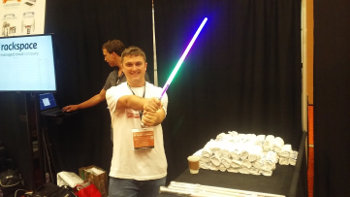There’s no need to fret over the future of desktop Linux; Raspberry Pi has that covered. It’s expanding the future of Linux in other ways as well. Let me explain.
At this very moment, thousands of children are hard at work tinkering with wires and connecting circuits to watch lights flicker on and off. They are typing lines of Python and are awestruck as a robotic arm comes to life for the first time. Smiles are widening on each child’s face as new boundaries are being crossed and experiments are taking shape. Linux has brought this joy into the lives of each of these children. How? Through the small but very powerful computer called the Raspberry Pi.

Photo by Multicherry
How is the Raspberry Pi expanding the future of Linux? When it comes to learning the craft of creating code, there are several beautifully crafted frameworks that can get children up to speed faster than any IDE or code book. First and foremost is the programming language Scratch. This language, created by the Lifelong Kindergarten group out of MIT, is geared towards teaching children how to program through an easy to navigate drag-and-drop interface. This interface allows the user to see their code come to life much more quickly than they would through a text editor or an IDE, which is exactly what is needed for a child’s attention span.
In addition to hosting a Raspberry Pi meetup in Washington D.C., Isaac Carter is a co-host on mintCast. He’s also a software engineer who enjoys working with Java, JavaScript, and GNU/Linux. When he’s not coding, you can find him reading on any number of subjects or on the golf course.




 Speaking of things as certain as gravity…
Speaking of things as certain as gravity…


 Meanwhile, in the world of free tech…
Meanwhile, in the world of free tech… Next up on Brother FOSS’s Traveling Salvation Show — pack up the babies and grab the old ladies and everyone go — brings the proverbial tent and revival show to Columbus, Ohio, at the beginning of next month.
Next up on Brother FOSS’s Traveling Salvation Show — pack up the babies and grab the old ladies and everyone go — brings the proverbial tent and revival show to Columbus, Ohio, at the beginning of next month. The good guys and gals at Linux Mint are on a roll, with three long-term support (LTS) releases in a row. It all started back in May of last year, with the release of 17.0, called Qiana, followed in January by
The good guys and gals at Linux Mint are on a roll, with three long-term support (LTS) releases in a row. It all started back in May of last year, with the release of 17.0, called Qiana, followed in January by 
 Welcome to the team, Hunter!
Welcome to the team, Hunter!
 But this year was okay as far as travel went. It was held in San Marcos Texas, the home of Texas State University. You can’t get more “in between” Austin and San Antonio than that. Personally, I think the miracle-working staff for TLF should think about making this their permanent home. Being between two of the four largest cities in Texas, people from each don’t think twice about making the drive, as opposed to those that would have to drive to Dallas or the Metroplex.
But this year was okay as far as travel went. It was held in San Marcos Texas, the home of Texas State University. You can’t get more “in between” Austin and San Antonio than that. Personally, I think the miracle-working staff for TLF should think about making this their permanent home. Being between two of the four largest cities in Texas, people from each don’t think twice about making the drive, as opposed to those that would have to drive to Dallas or the Metroplex.